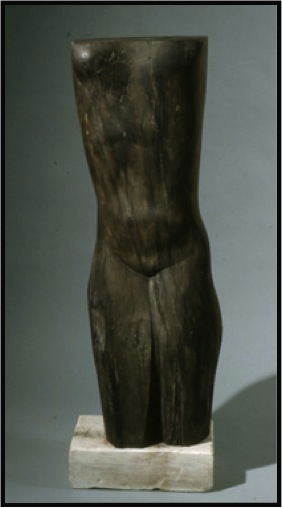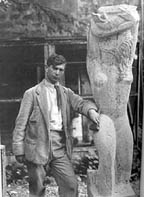
Ossip Zadkine
Russian, 1890-1967 (active France)
Torso, 1945
wood
36 3/8 x 11 x 10 in.
SBMA, Bequest of Wright S. Ludington
1993.1.25

Ossip Zadkine in the garden of his Paris studio which is now the Musée Zadkine, open to the public on rue d'Assas in the 6th Arrondissement. Image came with different title and date: Pomona, 1941, Ebony
COMMENTS
Ossip Zadkine was born in Smolinsk to a Scottish mother and Russian father, an ancient languages teacher in the local Seminary. His two uncles were boat builders on the Dnieper River, where he became familiar with the ancient tradition of stonemasons and wood carvers, forest dwellers who gave free expression to fantasies of animal forms and mighty tree trunks. At 16 he was sent to England to learn English but left to fulfill his dream of becoming an artist, arriving in Paris at 19, a gregarious young man who soon met Bourdelle and became friends with Lipchitz, who had arrived in Paris at the same time. In 1914 he joined the Foreign Legion, returning penniless, suffering from gas inhalation two and a half years later, to resume his studies in Paris. He is pictured to the right outside his Parisian studio, which is today the Musee Zadkine, open to the public, filled with his carved and cast works and some works in progress. He was known for a lyrical style, espousing Expressionism, which suited him best, but also incorporating the insights of Cubism into a style which reaches beyond both. By 1935 he had developed a Pantheistic fervor, investing his forms with a surging life and serving as an intermediary between flowing, organic form and the abstract interpretation of the life deep in plastic forms.
Description of the work
TORSO is minimally carved on a piece of weathered found wood, the grain and cracks adding fluidity to the carved line. Though it resembles an unworked tree trunk, the work exhibits an understated grace which immediately lets us know it is a young woman, from upper chest to thigh only, without arms, referencing the classical Aphrodite torsos. But as we observe more closely, we see incised on her chest the outline of an apple, suggesting a much earlier model, Eve herself. It is astonishing to realize how lithe and warm and alluring the figure becomes, considering the simplicity of the execution. This work displays that lyricism for which Zadkine is known, his facility in abstracting the essence of a form, his strong expressionistic line, but most of all the Pantheism which characterizes his work after 1935. The wood seems almost to breathe, and so give life to the form and persuades us the there is a spirit within the wood itself.
SBMA CURATORIAL LABELS
Pomona is the name of the Roman goddess of fruit and orchards. Through radical simplification of form and choice of hardwood, Zadkine fuses making and meaning, further underscoring the mythological identity of this literally truncated sculpture by incising leaves into the surface of the ebony. Pomona was one of the first sculptures Zadkine made after arriving in New York in 1941, where he would spend the duration of the Second World War. It was exhibited the following year at the Pierre Matisse Gallery in a show devoted to European artists in exile.
- Sculptures that Tell Stories, 2019
